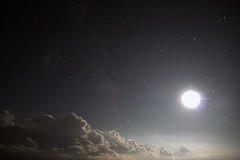Are you fascinated by space exploration? Do you dream of joining the 12 people in history who've walked on the moon? Before you don your space suit, check out these interesting facts about humans in space!
1) Before you can even think about becoming an astronaut, you must log at least 1,000 hours of flying in a jet aircraft. This will prepare you, at least somewhat, to go from zero to 17,000 miles per hour in less than nine minutes on the Space Shuttle.
2) Once you've been launched into space, astronauts receive 3.8 pounds of food a day. Most of the food is precooked and processed so that it doesn't require refrigeration. Some fresh fruits and vegetables are on board, but they must be consumed within the first couple days. Astronauts can season their meals with ketchup, mustard, and taco sauce, among other condiments provided on the Space Shuttle.
3) The food consumed during Apollo 11 included bacon squares, sugar cookie cubes, beef stew, and fruit cake. The astronauts quenched their thirst with coffee, fruit juice, and orange drink.
4) On Earth, space suits weigh a whopping 280 pounds. It takes the better part of an hour to put on a space suit, and each astronaut wears special undergarments.
For more interesting space facts, check out NASA's website.


 Equal Housing Opportunity
Equal Housing Opportunity